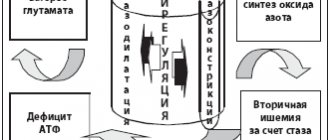Is a stroke a valid reason for disability?
Elderly citizens often face this problem, although the anomaly can also affect young people. In any case, experts divide stroke into:
- hemorrhagic, characterized by profuse bleeding of the brain, affecting most of it;
- ischemic, in which, against the background of minor hemorrhage, massive blockage of blood vessels is observed.
In both cases, a functional malfunction in the brain cannot be ruled out. For example, the following are diagnosed:
- paresis, paralysis;
- chewing dysfunction;
- decrease or loss of memory;
- deterioration in the ability to speak;
- visual abnormalities up to loss of function;
- problems with the musculoskeletal system.
One of the listed manifestations is often enough for experts to record the inability of the subject to take care of himself independently and his need for support (including from the state).
To cope with the consequences of the anomaly, exercise therapy, massage, and physiotherapy are used as rehabilitation. The more competent and quickly the health improvement measures were taken, the higher the chances of getting a light group.
Who is eligible for disability after a stroke?
The disease in question is included in the list of health problems that qualify for special status. But according to the law, in addition to diagnosis, ITU experts must observe a serious limitation of capabilities (at least one). That is, in case of successful rehabilitation, they are not sent for examination.
The question of establishing a group becomes relevant only if there is no positive result from treatment or if the prognosis is unfavorable (there is a risk of a second strike, etc.).
Determination of disability group after stroke in 2021
During the medical and social examination (MSE), doctors, before making a decision on assigning a group, take into account a number of criteria, the degree of loss of various opportunities, and more:
| Disability group | Degree of lesions | EDSS score | Characteristics |
| Third | 40-60% | 3,0-4,5 |
|
| Second | 60-80% | 5,0-7,0 | Despite the presence of persistent impairments, the patient is able to take care of himself. Work skills are often retained. |
| First | >80% | 7,5-9,5 |
· Requires constant care from another person. |
In the process of examination, in addition to the state of health, the social component of the subject’s life, conditions, etc. are taken into account.
What disability groups can be established after a stroke?
The commission establishes the disability group as a result of the illness in accordance with the criteria for assessing the patient’s condition. There are many criteria by which group membership can be assessed, the main ones being:
- the patient’s dependence on other persons – the ability or impossibility of self-care;
- the ability to move the patient;
- spatial orientation;
- communication criterion;
- control of patient behavior.
Let's consider the main criteria for establishing disability for each of the groups: Group I (first group of disability) - the basis for establishing a stroke is persistent motor and functional impairments of high severity, which led to a sharp limitation of normal life activities and deprivation of the patient’s ability to self-care, resulting in the need for constant care for the victim. Group II (second disability group) - the basis for the diagnosis of stroke is persistent functional impairment of severe severity. The group is established for patients who have retained the ability to self-care, but are unable to work. Group III (third disability group) - the basis for the diagnosis of stroke is the presence of persistent functional disorders of moderate severity in the patient, which may disappear after some time. The group is established for able-bodied patients with minor health disorders for whom certain types of work may be contraindicated.
Important! Establishing disability in the event of a stroke implies re-examination, taking into account the possibility for the patient to return to normal life and work activity upon restoration of dysfunction. However, after 4 years, if there are no changes, the disability group is established indefinitely.
Prohibition on certain types of work activities
The right to work remains despite the special status, although the recipient must work taking into account his capabilities and medical recommendations. After a stroke, it is usually advised to avoid:
— harmful working conditions;
— psychological stress;
- standing on your feet for a long time;
— low temperatures for many hours;
In general, before employment, a worker with a disability should assess all risks to avoid recurrent stroke.
Basic benefits when receiving disability
A special status caused by a stroke provides benefits and cash payments. The amount of assistance provided is similar to what is guaranteed to other citizens with disabilities:
| Types of benefits | Examples |
| Financial | 1. Payment of benefits according to the established group. 2. EDV. 3. Additional payments depending on various conditions: regional, for dependents or up to the subsistence level. |
| Tax | A discount on tax payments or their complete cancellation. |
| Housing | 1. Providing real estate for ownership or lease. 2. Subsidizing payment for housing and communal services. 3. Compensation for 50% of the amount spent on utility bills. |
| Social | 1. Free travel on public transport. 2. Job quotas. 3. Discount on purchasing train tickets. 4. Admission to a university under special conditions. |
| Medical | 1. Extraordinary care in hospitals. 2. Issuing prescription medications free of charge. 3. Free trip to the sanatorium. |
If the problem has caused paralysis, visual, auditory or other anomalies, the necessary devices (hearing aid, cane, etc.) are provided to compensate for lost capabilities. But special TSRs specifically for stroke patients are not provided.
Who is entitled to disability benefits in 2021?
All disabled people who have officially confirmed their status can count on receiving disability payments.
The medical institution issues a conclusion about a persistent decline in health; you will regularly have to undergo a commission again so that the doctor can make sure that there is no improvement. Depending on the state of health in the Russian Federation, several disability groups are distinguished:
| Disability group | Characteristics and Features |
| First | A disabled person is completely dependent on third parties; he cannot navigate in space, control himself, or move. |
| Second | A disabled person can work with the help of auxiliary tools, orient himself in space, and is able to move. |
| Third | There is a serious illness that does not interfere with working with loyal demands. |
| Disabled children | There is no division into groups for people under 18 years of age. |
These categories of citizens can count on payment of benefits in the established amount. They are provided with additional benefits and are assigned monthly and one-time disability benefits.
Loan secured by PTS CashDrive, Person. No. 005928
from 0.06%
rate per day
up to 1 million
90 – 2,555 days
Take out a loan
Registration process
First of all, the attending physician or social security representative must refer the patient to a medical examination. Only the officially recorded diagnosis is considered, medical records are taken into account. maps and present lesions.
You can apply for the group after your condition has stabilized, that is, when at least 4 months have passed since the impact. If there are grounds for assigning a disability, the doctor first sends you for tests and examinations and only after that sends you to an ITU.
List of documents
According to the law, a potential beneficiary presents to the ITU Bureau:
— your SNILS and passport;
— application form 088/у-06;
— extracts from the medical history;
- referral for examination.
A reference from the place of work is attached if the person being examined was employed before the illness.
Where to contact
With the prepared documents on a specific day, you should appear for a commission at the ITU bureau (by registration or by type of illness - there may be such departments in the regions).
Refusal to provide a certificate of disability
The inspection procedure involves assessing:
— general condition;
— degree of deterioration of capabilities;
— the impact of the problem on the quality of life.
After the inspection, questioning, and study of documents, the commission members deliberate, vote and notify the examinee of their decision. The status may not be assigned when:
— criteria have not been identified that would allow establishing even the easiest group 3;
- the documents are fake (here it can even lead to a criminal case).
How to appeal an ITU decision
If a negative decision is regarded as violating the rights of the beneficiary, you can appeal the ITU result step by step. To do this you should:
- seek new direction;
— provide a package of papers to a higher bureau;
— repeat the health assessment procedure.
If you refuse again, you can go to court. Additionally, the involvement of an independent expert is allowed.
Registration of disability
If, after conservative/surgical treatment and a rehabilitation course, the patient has not recovered all body functions (for example, there are problems with memory, visual perception has deteriorated, coordination of movements is impaired), then a decision is made to assign disability.
A person with a history of stroke undergoes a full medical examination at the place of treatment, and with the results obtained goes to the bureau of medical and social examination.
If the patient has high blood pressure, there are symptoms of severe central nervous system disorders, it is possible to obtain disability in absentia.
Depending on the degree of complications after a stroke, disability groups 1-2-3 are assigned. The third group involves maintaining the ability to work, but only light work is allowed.
With the assignment of disability, the patient is assigned a pension benefit, he has the right to a set of social services (he can refuse, and it is replaced with a monthly supplement to his pension). Also, a person who has had a stroke may benefit from subsidies for utilities and other benefits that are available to persons with disabilities.
Peculiarities of assigning disability in non-standard cases
Since after a stroke the consequences can be very unpredictable, various nuances are taken into account when establishing disability. Let's take a closer look at them.
Pensioners
Preferential status in this case is formalized in the same way as when examining other patients. That is, the requirements are similar to those described above. The only significant difference is the ability to immediately receive a group for life. In any case, after being assigned a disability, the pensioner must additionally contact the Pension Fund to recalculate the pension.
Unemployed
The health of citizens who do not have a permanent place of work is assessed by specialists according to standard criteria for all. It’s even a little easier for the unemployed, since they don’t have to wait 4 months and apply for sick leave like employed people. But without work experience, you are only entitled to a social disability pension.
Bedridden patients
In difficult situations, when a potential beneficiary is not able to visit the ITU office, there are several options:
— carry out a health check at home or in a hospital;
— make a decision based on the medical history and other documents without the patient’s personal presence.
Disability insurance payment
Paid if two conditions are met:
- There is any disability group.
- I have experience.
The disability insurance pension depends on several factors:
- groups;
- duration of employment;
- fees paid;
- presence in the family of persons under care;
- region of residence.
Online loan Monetkin Monetkin, Lits. No. 005894
from 0.4% per day
First loan 0%
up to 100 thousand
1 — 365 days.
Take out a loan
The amount of the insurance pension includes a fixed part, which is determined by the government and indexed every year. The amount of disability benefits is calculated taking into account the group, family and social status, and length of service.
Re-examination
If the disability is not permanent and requires periodic confirmation of the group, the beneficiary is required to undergo another examination before the certificate expires. In addition, the condition assessment process may be caused by deterioration in performance.
Be that as it may, the criteria established by law are always considered and taken into account. And if you miss the moment when the certificate expires, your pension and benefits will be cancelled.
| Disability group | Validity period of the certificate |
| First, second | 2 years |
| Third | 1 year |
By the way, if your health deteriorates significantly, you can even reconsider the indefinite group.








